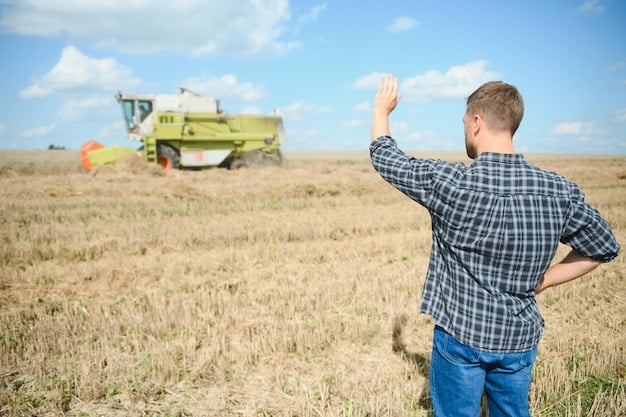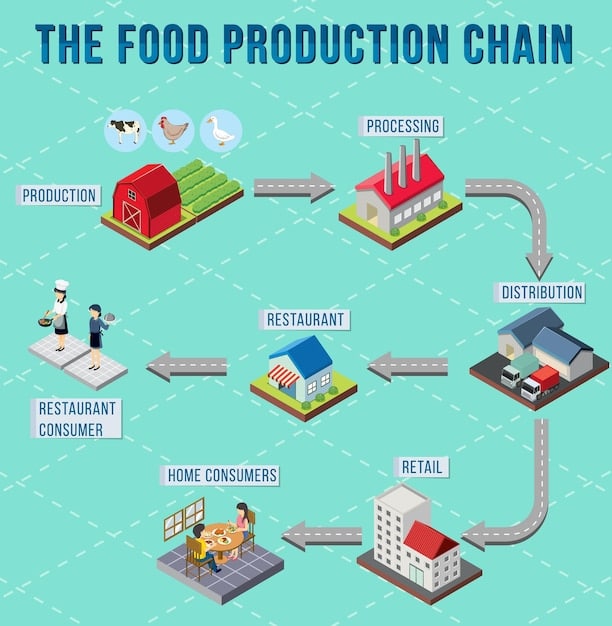US Agricultural Policy Update: Subsidies & Food Prices in Coming Months

The latest US agricultural policy updates, particularly new subsidy programs, are poised to significantly influence food prices in the coming months by impacting farmer production decisions, supply chain stability, and consumer costs, creating a complex interplay of economic forces.
The landscape of agriculture is perpetually evolving, shaped by a confluence of environmental, economic, and political factors. A critical element influencing this dynamic is government policy, specifically in the form of subsidies. This article will delve into the recent US Agricultural Policy Update: How New Subsidies Will Affect Food Prices in the Coming Months, exploring the intricate connections between legislative actions, farmer incentives, and ultimately, the cost of food on your table.
Understanding the Latest US Agricultural Policy Shifts
The recent changes in US agricultural policy represent a strategic pivot aimed at addressing multifaceted challenges within the food system, from sustainability to economic stability for farmers. These shifts are not merely incremental adjustments but reflect a deeper reevaluation of how the nation supports its agricultural backbone. Consequently, these policy modifications are expected to ripple through the entire food supply chain, influencing everything from farm-gate prices to consumer expenditure.
Key Policy Directives and Their Immediate Implications
The updated framework introduces several key directives that merit closer examination. One of the most prominent is the re-evaluation of direct payment programs, moving towards more targeted assistance. This aims to ensure that subsidies primarily benefit those farmers who face genuine economic vulnerabilities or who adopt environmentally sound practices. The immediate implication is a potential redistribution of funds, favoring smaller and mid-sized operations over larger, more established ones.
Another significant directive involves an increased emphasis on conservation programs. This includes financial incentives for farmers to implement practices that enhance soil health, conserve water, and reduce greenhouse gas emissions. While the long-term benefits are clear, the short-term impact could lead to shifts in crop rotation and land use as farmers adapt to these new incentives. This adaptation might temporarily affect the supply of certain commodities.
Furthermore, there is a renewed focus on risk management tools, such as crop insurance and disaster assistance. These measures are designed to provide a stronger safety net for farmers in the face of unpredictable weather patterns and market volatility. By mitigating risk, these policies aim to encourage continued production, even in challenging conditions.
- Shifting from broad direct payments to targeted assistance programs.
- Increased funding and incentives for advanced conservation practices.
- Enhancements to existing crop insurance and disaster relief mechanisms.
- Potential for a rebalance in support towards smaller agricultural enterprises.
These policy changes are not implemented in a vacuum. They are a response to mounting pressures, including climate change, global trade dynamics, and evolving consumer demands for sustainable and ethically produced food. The intent is to foster a more resilient, equitable, and environmentally conscious agricultural sector, even as the immediate effects might present adjustment challenges for various stakeholders within the system. The success of these policies will largely depend on their implementation efficiency and the agricultural sector’s capacity to adapt.
New Subsidies and Their Direct Influence on Farm Production
The introduction of new subsidy programs is inherently designed to alter farmer behavior and, by extension, agricultural production patterns. These financial incentives can sway decisions ranging from what crops to plant, how much land to cultivate, and which farming techniques to employ. Understanding this direct influence is crucial for forecasting shifts in commodity availability and, ultimately, food prices.
Incentivizing Specific Crops and Practices
Historically, subsidies have often been criticized for encouraging monoculture or overproduction of certain commodities, sometimes leading to market gluts and depressed prices for farmers. The new wave of subsidies appears to be more strategically designed, aiming to incentivize specific crops that align with national food security goals or environmental sustainability targets. For instance, there might be enhanced support for specialty crops, organic farming, or even a push for diversification away from traditional commodity crops like corn and soybeans, particularly in regions where environmental concerns are paramount.
This targeted approach could lead to an increase in the production of previously underrepresented crops, potentially diversifying the domestic food supply and reducing reliance on imports for certain goods. Conversely, it might slightly dampen enthusiasm for crops that traditionally received substantial support but are now less prioritized.
The subsidies also aim to encourage the adoption of more sustainable farming practices. This includes financial aid for implementing precision agriculture technologies, reducing water usage, improving nutrient management, and diversifying crop rotations to enhance soil health. Farmers might be more inclined to invest in these practices, even if they incur upfront costs, knowing that long-term subsidies will offset these expenditures. This shift towards sustainable production, while beneficial for the environment, can sometimes lead to lower yields in the initial transition phase or higher production costs, which could then trickle down to consumer prices.
- Direct payments for implementing advanced conservation agriculture.
- Financial incentives for diversifying crop portfolios to include specialty commodities.
- Support for transitioning to organic farming methods.
- Subsidies tied to water efficiency and sustainable land management.
Impact on Agricultural Inputs and Technology Adoption
New subsidies can significantly influence the demand for agricultural inputs such as fertilizers, seeds, and machinery. If a subsidy encourages the cultivation of a specific crop, the demand for inputs associated with that crop will likely increase. This can lead to price fluctuations for those inputs, which farmers then factor into their production costs. Moreover, subsidies often accelerate the adoption of new technologies. For example, if there are subsidies for precision agriculture equipment, more farmers will likely invest in GPS-guided tractors and drones, leading to increased efficiency but also potentially higher initial capital expenditures for the industry.
The long-term effect of these production shifts is complex. While increased supply of certain subsidized crops might theoretically lower their prices for consumers, the overall cost of production (factoring in input prices and technology investments) could also rise, creating a nuanced scenario for food prices. The balance between incentivizing specific outputs and maintaining overall market stability is a delicate one that these new policies aim to strike.
Supply Chain Stability: How Subsidies Reduce Volatility
Agricultural supply chains are inherently susceptible to a host of disruptions, from extreme weather events and pest outbreaks to market fluctuations and geopolitical tensions. New US agricultural subsidies are designed, in part, to inject a greater degree of stability into these complex systems, thereby potentially mitigating steep price swings for consumers. By providing a financial buffer and encouraging resilient practices, these policies aim to create a more dependable flow of food from farm to table.
Mitigating Risks for Farmers
A primary mechanism through which subsidies enhance supply chain stability is by mitigating financial risks for farmers. Agriculture is a high-risk enterprise, and without adequate support, many farmers might be forced out of business during periods of low prices or devastating crop failures. New subsidies, particularly those focused on insurance and disaster relief, act as a safety net. For instance, enhanced crop insurance programs ensure that farmers receive compensation for losses due to unforeseen events, allowing them to remain solvent and continue planting in subsequent seasons. This continuity of production is vital for maintaining a consistent supply of commodities.
Moreover, subsidies that encourage diversification of crops or the adoption of climate-resilient farming practices inherently build resilience at the farm level. A farmer growing multiple crops or implementing drought-resistant irrigation systems is less likely to experience a complete loss, ensuring that some produce will still enter the supply chain. This distributed resilience prevents single points of failure from causing widespread shortages. The financial stability provided by these programs can also encourage long-term investments in farm infrastructure, further bolstering future production capacity.

Ensuring Consistent Commodity Flow
The ripple effect of farmer stability extends directly to the consistency of commodity flow within the supply chain. When farmers are economically secure, they are better positioned to make long-term planting decisions, invest in appropriate technologies, and maintain their land and equipment. This predictability in production is essential for processors, distributors, and retailers who rely on a steady supply of raw materials. Without it, these downstream actors would face increased uncertainty, leading to potential delays, higher operational costs, and ultimately, inflated consumer prices.
Furthermore, some subsidies might indirectly support supply chain infrastructure development. For example, policies encouraging local and regional food systems can lead to investments in local processing facilities, transportation networks, and storage solutions. These localized infrastructures can reduce reliance on long-distance transport, minimize waste, and create more agile supply chains that are less vulnerable to national or global disruptions. By strengthening these linkages, subsidies do not just support farmers; they fortify the entire pipeline that delivers food to markets, making the system more robust against unforeseen shocks and contributing to more stable food prices for consumers.
Examining the Potential Impact on Consumer Food Prices
The ultimate question for consumers is how these agricultural policy updates and new subsidies will translate into changes at the grocery store. The relationship between farm policy and retail food prices is complex, influenced by a multitude of factors beyond just agricultural subsidies. However, subsidies do play a significant role, potentially pushing prices up or down depending on their design and market responses.
Upward and Downward Pressure on Prices
New subsidies can exert both upward and downward pressure on food prices. On one hand, subsidies designed to encourage sustainable practices or specific crops often come with increased production costs for farmers, at least initially. For instance, transitioning to organic farming or implementing advanced conservation methods might require higher labor inputs or specialized equipment. If these increased costs are not fully offset by the subsidy, farmers might pass some of them on to consumers in the form of higher prices for the finished product. Similarly, direct payments that stabilize farmer income might remove some incentive for farmers to lower prices aggressively during periods of oversupply.
Conversely, subsidies can also lead to downward pressure on prices. If a subsidy significantly boosts the supply of a particular commodity, the increased availability in the market could drive prices down. This is particularly true for basic commodities where increased production can quickly lead to market saturation. Furthermore, long-term investments in efficiency and technology, spurred by subsidies, can lower the per-unit cost of production over time, eventually benefiting consumers through lower prices. Subsidies that mitigate risk, such as crop insurance, can prevent sharp price spikes that would otherwise occur during widespread crop failures by ensuring continued, albeit reduced, supply.
| Potential Impact on Prices | Mechanism |
|---|---|
| 📈 Upward Pressure | Increased production costs for sustainable practices; removal of downward pressure during oversupply. |
| 📉 Downward Pressure | Increased supply due to incentives; long-term efficiency gains; risk mitigation via insurance. |
The Role of Market Dynamics and Consumer Demand
It is critical to remember that subsidies are only one piece of the puzzle. Retail food prices are also heavily influenced by broader market dynamics. These include consumer demand shifts (e.g., increasing preference for plant-based foods), energy costs (which impact transportation and processing), labor availability and wages in the food sector, and global supply and demand for commodities. A particular subsidy might increase the supply of a specific crop, but if consumer demand for that crop simultaneously spikes, the price may not fall as much as theoretically expected.
Moreover, the behavior of intermediaries in the supply chain—processors, wholesalers, and retailers—plays a significant role. These entities add their own markups based on their operational costs, competitive landscape, and profit margins. Even if farm-gate prices are influenced positively by subsidies, these benefits might not always be fully passed on to consumers if intermediaries face their own rising costs or choose to absorb potential savings. Therefore, while new subsidies aim to create a more stable and potentially affordable food supply, their ultimate effect on what consumers pay at checkout will depend on a confluence of factors that interact dynamically within the complex food economy.
Regional Variances in Policy Impact and Food Accessibility
The US is a vast and agriculturally diverse nation, meaning that the impact of new agricultural policies and subsidies will not be uniform across all regions. Different states and localities possess unique agricultural profiles, economic structures, and environmental challenges. Understanding these regional variances is crucial for a comprehensive assessment of how these policies will affect food accessibility and prices at a local level.
Geographic and Climatic Differences
The most apparent source of regional variance lies in the geographic and climatic differences across the US. A policy designed to support corn and soybean production in the Midwest will have minimal direct impact on the fruit and vegetable growers in California or the cattle ranchers in Texas. Similarly, subsidies targeting water conservation will be highly relevant in drought-prone Western states but less so in the humid Southeast. Policies promoting specific sustainable practices, such as no-till farming, might be more readily adopted in certain soil types than others.
As a result, the benefits and potential drawbacks of new subsidies will be felt disproportionately. Regions specializing in crops that receive enhanced subsidy support may see increased prosperity and production, potentially leading to lower local prices for those specific commodities. Conversely, regions whose primary agricultural outputs are less prioritized by the new policies might find themselves at a relative disadvantage, potentially leading to local price increases or reduced availability for certain goods if production declines. This regional disparity can exacerbate existing inequalities in food accessibility.

Economic and Social Implications for Local Communities
Beyond direct agricultural production, new subsidies carry significant economic and social implications for local communities. In regions heavily reliant on agriculture, policy changes can shape employment opportunities, local business viability, and overall community well-being. For example, if subsidies encourage consolidation of farms or a shift towards highly mechanized operations, it could impact local labor markets, potentially reducing demand for farmworkers. Conversely, policies supporting small and mid-sized farms or promoting niche agricultural markets could stimulate local economies by fostering entrepreneurship and diversifying income streams.
Moreover, food accessibility for consumers can vary considerably by region. Urban areas often rely on complex supply chains that source food from diverse agricultural areas, making them sensitive to broad national policy shifts. Rural communities, particularly those in food deserts, might be more directly impacted by changes in local farming practices and the availability of specific commodities. A policy that boosts local vegetable production could significantly improve food access in a rural community, whereas a policy that makes large-scale commodity farming more profitable might divert land from local food production. Therefore, the regional lens is not just about agricultural output, but also about the intricate social and economic fabric that underpins food systems across the diverse American landscape.
Beyond the Farm Gate: Processing, Transportation, and Retail Costs
While agricultural subsidies directly affect farmers and their production decisions, their influence on food prices extends far beyond the farm gate. The journey of food from field to fork involves a complex network of processing, transportation, and retail operations, each adding its own layers of cost. Understanding how these elements interact with new subsidy policies is crucial for a complete picture of future food prices.
Processing and Manufacturing Dynamics
Once crops leave the farm, they often undergo significant processing and manufacturing. This can range from simple cleaning and packaging to complex transformation into prepared meals or ingredients for other products. The costs incurred at this stage—including labor, energy, equipment maintenance, and packaging materials—are substantial components of the final retail price. While new agricultural subsidies might reduce the raw material cost for processors, these savings may not always be fully passed on to consumers if the processors themselves face rising operational costs. For instance, an increase in energy prices or labor wages can easily offset any gains from cheaper agricultural inputs.
Furthermore, subsidies can indirectly affect processing dynamics by influencing crop availability and quality. If a subsidy encourages the production of a higher-quality crop, it might command a better price from processors, which could in turn lead to slightly higher prices for premium processed goods. Conversely, if subsidies lead to a glut of a particular commodity, processors might be able to purchase it at a lower price, potentially leading to more affordable processed foods if competitive pressures encourage them to pass on savings. The efficiency and capital investments within the processing sector, though not directly subsidized by agricultural policy, play a crucial role in how farm-level changes translate to consumer prices.
Transportation and Retail Margins
Transportation costs are a significant factor in the final price of food, especially in a vast country like the US. Fuel prices, labor costs for drivers, and the efficiency of logistical networks all contribute to getting food from farms and processing plants to distribution centers and retail stores. New subsidies typically do not directly impact transportation costs, but they can indirectly influence them by altering the geographic distribution of production or the volume of goods needing transport. For example, if policies incentivize more localized food systems, it could reduce long-haul transportation costs, potentially leading to lower prices for locally sourced products.
At the retail level, supermarkets and other food vendors add their own significant margins to cover operational expenses, marketing, and profit. These margins are influenced by competition, store overheads, and consumer demand. Even if subsidies help lower the cost of food at the farm or processing level, retailers ultimately determine the shelves’ final pricing. They might absorb some of the cost reductions to increase their profit margins or pass them on to consumers, depending on their business strategy and the competitive landscape. Therefore, while agricultural subsidies lay the groundwork at the production end, the economic realities of transportation, processing, and retail remain powerful determinants of what finally appears on consumers’ bills.
Looking Ahead: Long-Term Projections and Consumer Preparedness
Forecasting the long-term effects of new agricultural subsidies on food prices is a complex undertaking, involving economic models, market trend analysis, and an understanding of climate and geopolitical shifts. While immediate impacts may be visible in the coming months, the full implications of these policy updates often unfold over several years. For consumers, this necessitates an understanding of potential trends and strategies for preparedness.
Projected Trends in Food Costs and Availability
In the long term, new subsidies that encourage efficiency, technological adoption, and sustainable practices could lead to a more resilient and productive agricultural sector. This robustness could, in turn, contribute to greater stability in food supply and potentially mitigate sharp price increases caused by production shortfalls. If policies successfully foster crop diversity and climate resilience, the food system as a whole might become less vulnerable to extreme weather events, which have historically driven up prices. However, the initial transition to new farming methods, some of which may be more resource-intensive or yield lower returns in the short term, could create temporary upward pressure on prices for specific commodities.
Another projected trend relates to the availability of certain foods. If subsidies effectively steer farmers towards growing particular crops (e.g., specialty grains, locally sourced produce), consumers might see greater availability and variety of these items, potentially at more competitive prices as supply increases. Conversely, if traditional commodity crops receive less strategic support, their overall share in the market might decline, potentially leading to price increases or a shift in consumption patterns as alternatives become more attractive. The key will be monitoring how market forces react to these policy-induced shifts in agricultural output.
Strategies for Consumer Preparedness
For consumers, understanding these dynamics allows for proactive strategies to manage food budgets and dietary choices. One key strategy is to remain informed about which agricultural sectors or specific commodities are receiving significant policy attention, as this could signal future price trends. For instance, if there’s a strong push for domestic vegetable production, consumers might anticipate more affordable and abundant options in local markets.
Another strategy involves embracing dietary flexibility. If certain types of food experience price volatility due to policy shifts or other market factors, being open to incorporating alternative ingredients or seasonal produce can help manage costs. Supporting local farmers and farmers’ markets can also be beneficial; sometimes, direct-to-consumer sales can offer more stable or even lower prices for fresh produce, bypassing some of the intermediary costs of the conventional supply chain. Finally, long-term preparedness might also involve advocating for agricultural policies that prioritize both farmer prosperity and consumer affordability, ensuring a balanced approach to the nation’s food future.
The Interplay of Policy, Market, and Consumer Behavior
Ultimately, the future of food prices is not solely determined by policy, nor by market forces in isolation, but by a complex and dynamic interplay between agricultural policies, market reactions, and consumer behavior. New US agricultural subsidies are designed to guide the agricultural sector towards specific outcomes, but their real-world impact is filtered through the decisions of millions of farmers, businesses, and individual consumers.
Feedback Loops and Adaptations
Policy decisions do not operate in a vacuum; they create feedback loops. As farmers adapt to new subsidy programs, their production choices influence supply. This altered supply then impacts market prices, which in turn can influence consumer demand. For example, if a subsidy leads to a surge in the availability of a particular vegetable, its price may drop, encouraging consumers to purchase it more frequently. This increased demand then signals back to farmers, potentially reinforcing the economic viability of growing that vegetable. Conversely, if a policy inadvertently leads to an oversupply that crashes prices, farmers might adjust their planting decisions in future seasons, illustrating another part of the feedback loop.
Market actors—processors, distributors, and retailers—also demonstrate adaptive behavior. They respond to changes in raw material costs, transportation fees, and consumer purchasing habits. If they find it cheaper to source certain ingredients due to new subsidies, they might adjust their product offerings or pricing strategies. These adaptations by businesses are crucial in translating farm-level policy impacts into retail price changes. The effectiveness of any agricultural policy, therefore, hinges on its ability to anticipate and constructively shape these intricate feedback loops.
Empowering Consumers Through Knowledge
For consumers, understanding this sophisticated interplay is a significant step towards empowerment. It moves beyond simply reacting to price changes at the grocery store to appreciating the underlying factors at play. Knowledge about agricultural policies can inform personal shopping decisions, from choosing seasonal produce to understanding the value proposition of certain food items. It also enables more informed engagement with the broader food system.
By being aware of the goals and potential effects of new subsidies, consumers can better advocate for policies that align with their values—whether those are affordability, sustainability, or support for specific types of farming. In a world where food costs are increasingly a concern, an informed consumer base is not just a passive recipient of market outcomes but an active participant in shaping the future of food production and accessibility. The journey from policy drafting to fork is long and winding, but appreciating its twists and turns allows everyone to navigate it more effectively.
| Key Aspect | Brief Description |
|---|---|
| 🌾 Policy Shifts | New US agricultural policies target sustainable practices & risk reduction. |
| 💰 Farmer Subsidies | Incentivize specific crops/methods, affecting production costs & output. |
| 🛒 Consumer Prices | Can create both upward (cost absorption) and downward (increased supply) pressure. |
| 🌍 Regional Impact | Effects vary widely by climate, local economy, and predominant agricultural activity. |
Frequently Asked Questions About Agricultural Policy & Food Prices
New US agricultural subsidies primarily aim to enhance farm income stability, promote environmentally sustainable farming practices, and strengthen the overall resilience of the food supply chain against disruptions like climate change and market volatility. They seek to balance economic viability for farmers with broader societal goals.
Subsidies influence crop choices by making certain crops or farming methods more financially attractive. Farmers might receive direct payments or insurance benefits for cultivating specific commodities, adopting conservation techniques, or diversifying their operations. This makes those choices more profitable or less risky, encouraging their adoption.
Not necessarily. While increased supply due to subsidies can lower prices, other factors like rising energy costs, labor wages, processing fees, and retail margins also impact final prices. Some subsidies might also increase initial production costs for farmers or reduce their incentive to aggressively lower prices.
The impact will vary significantly by region due to differences in climate, predominant agricultural activities, and economic structures. Policies supporting specific crops or conservation methods will benefit regions aligned with those goals more directly, while other regions might see less direct impact or even indirect challenges.
Consumers can stay informed by following agricultural news, understanding the focus of new policies, and observing local market trends. Being aware of peak seasons for certain crops and considering supporting local food systems, such as farmers’ markets, can also provide insight into price dynamics.
Conclusion
The recent update to US agricultural policy, with its emphasis on new subsidy programs, marks a pivotal moment for the nation’s food system. These nuanced changes are designed to foster a more resilient, sustainable, and economically stable agricultural sector, aiming to secure food production for generations to come. While the exact trajectory of food prices remains subject to a myriad of market forces, these policies lay critical groundwork. By influencing farmer decisions, stabilizing supply chains, and encouraging environmentally sound practices, they inherently shape the future of food accessibility and cost. For consumers, understanding this complex economic dance is key to navigating the evolving landscape of grocery bills and making informed decisions about what lands on their tables in the coming months.





